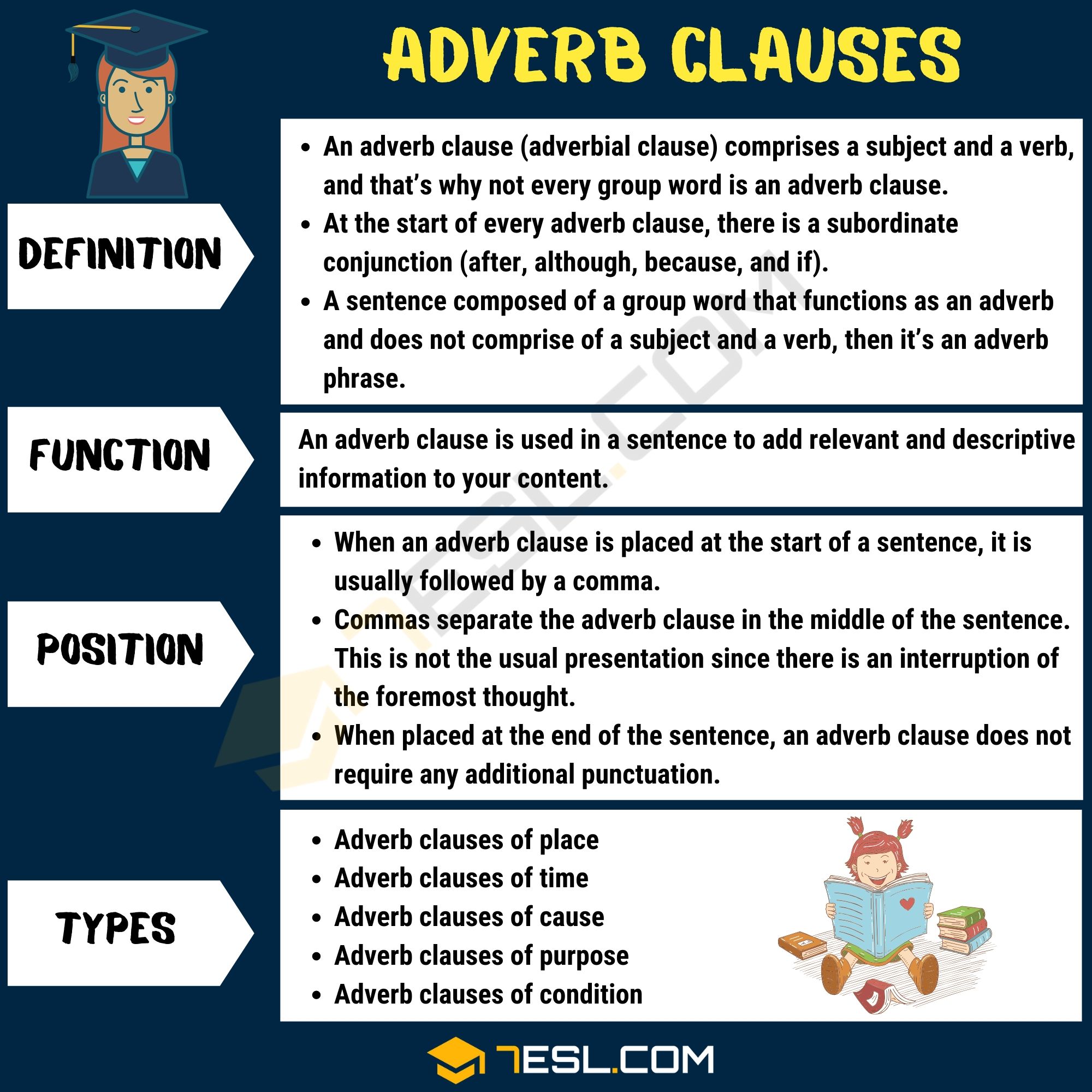

Adverb clauses are very popular in the English language, allowing for greater clarity and specificity in sentence structure. These clauses function as adverbs, and can sometimes be confused with adverb phrases. To further explore the different types of adverb clauses, their functions, and how to use them effectively in writing, please read on. Understanding adverb clauses can be a valuable asset to enhance the quality of your writing.
Adverbial Clauses | Picture

An adverb clause, also known as an adverbial clause, comprises a subject and a verb, and that’s why not every group word is an adverb clause. At the start of every adverb clause, there is a subordinate conjunction. Examples of subordinate conjunctions include: after, although, because, when and if. A sentence composed of a group word that functions as an adverb and does not comprise of a subject and a verb, then it’s an adverb phrase. Please do not confuse the two.
For example, in the sentence “He walks home when it rains,” the adverb clause “when it rains” provides information about the time or condition when the action of walking home occurs. The subordinating conjunction, ‘when,’ introduces the adverb clause, and the clause modifies the verb ‘walks.’
What are the uses of adverb clauses?
An adverb clause is used in a sentence to add relevant and descriptive information to your content. Adverb clauses are flexible enough in that they can be used in different parts of a sentence. For instance, they can be placed at the start, middle, or end of a sentence, based on where they perfectly fit.
When an adverb clause is placed at the start of a sentence, it is usually followed by a comma. This is illustrated in the following examples:
Commas separate the adverb clause in the middle of the sentence. This is not the usual presentation since there is an interruption of the foremost thought. An example of this is illustrated below:
When placed at the end of the sentence, an adverb clause does not require any additional punctuation. Examples of this include:
Keep in mind to check for a subject and a verb if you are not sure whether a group of words is an adverb clause or not. If it is composed of a verb and a subject and it does answer the question when, where, how then it’s an adverb clause. You should always remember to use adverb clauses properly since they add more descriptive information, thereby bringing relevance to your work and making it useful as much as possible.
Adverbial clauses are grouped into the following categories:
Adverb clauses of place describe where an action takes place. These clauses are typically introduced by conjunctions like where or wherever. They provide spatial information, which can help create vivid images and make the text more engaging.
Adverb clauses of time explain when an action occurs. They are often introduced by conjunctions such as when, while, before, after, as soon as, or until. These clauses help establish a clear order of events or provide context for the reader.
Adverb clauses of cause and effect clarify the reasons behind an action or event. They often start with conjunctions such as because, since, or as. These clauses help to explain the correlations between different situations or incidents.
Adverb clauses of purpose describe the intended result or purpose of an action. These clauses are introduced by conjunctions like so that, so. They provide additional information about why something was done.
Adverb clauses of condition illustrate a particular circumstance in which an action will occur. Common conjunctions introducing conditional clauses include if, unless, or in case. These clauses help to convey hypothetical scenarios or specific conditions tied to the main action of the sentence.
Adverb clauses of manner explain how an action is carried out. They often begin with conjunctions like as, as if, or as though. These clauses provide details on the way events happen or the manner in which actions are performed, adding depth and nuance to descriptions.
Adverb clauses of concession describe a situation in which the outcome is contrary to what is expected or desired. These clauses are introduced by conjunctions like although, even though, while, despite, and in spite of, followed by a clause. Some other typical examples are: whatever, whenever, wherever, even if, no matter, and whereas. They provide additional information that contrasts with the main clause.
Reduced adverbial clauses are condensed versions of adverb clauses. To successfully reduce an adverb clause, the subject of the dependent (the adverb clause) and independent clause must be the same.
To reduce adverb clauses of time, follow these steps:
For example, consider the following sentence:
“When Sandra graduated from university, she applied for a job.”
We can reduce the adverbial time clause and rewrite the sentence as:
“Upon/After/When graduating from university, Sandra applied for a job.”
For adverb clauses of reason, you can remove the subordinating conjunction, subject, and the ‘to be’ form of a verb.
Here’s an example:
“Because he was feeling hungry, he decided to eat a sandwich.”
The reduced clause in this sentence would look like:
“Feeling hungry, he decided to eat a sandwich.”
Here’s an example of adverb clauses and its reduced form in passive voice:
“As he was called a liar, he decided to change school.”
The reduced clause in this sentence would look like:
“Called a liar, he decided to change school.”
Use these guidelines to condense adverb clauses and present your ideas more concisely. However, be cautious when simplifying the clauses, and always ensure that the meaning is clear and accurate to avoid confusion.
An experienced English grammar teacher since 2015, with a dedication to helping students improve their language skills.
Latest posts by Grammargeek (see all)